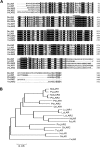Molecular cloning and characterization of PtrLAR3, a gene encoding leucoanthocyanidin reductase from Populus trichocarpa, and its constitutive expression enhances fungal resistance in transgenic plants
- PMID: 22268151
- PMCID: PMC3346219
- DOI: 10.1093/jxb/err425
Molecular cloning and characterization of PtrLAR3, a gene encoding leucoanthocyanidin reductase from Populus trichocarpa, and its constitutive expression enhances fungal resistance in transgenic plants
Abstract
The flavonoid-derived proanthocyanidins (PAs) are one class of the major defence phenolics in poplar leaves. Transcriptional activation of PA biosynthetic genes, resulting in PA accumulation in leaves, was detected following infection by the fungal Marssonina brunnea f.sp. multigermtubi using digital gene expression analysis. In order to study PA biosynthesis and its induction by fungi, a putative leucoanthocyanidin reductase gene, PtrLAR3, was isolated from Populus trichocarpa. Sequence comparison of PtrLAR3 with other known leucoanthocyanidin reductase proteins revealed high amino acid sequence similarity. Semi-quantitative reverse-transcription (RT) PCR and quantitative real-time PCR analysis demonstrated that PtrLAR3 was expressed in various tissues and the highest level of expression was observed in roots. Overexpression of PtrLAR3 in Chinese white poplar (Populus tomentosa Carr.) led to a significant plant-wide increase in PA levels. In vitro assays showed that crude leaf extracts from 35S:PtrLAR3 transformants were able to inhibit significantly the hyphal growth of M. brunnea f.sp. multigermtubi compared to the extracts from control plants. The transgenic 35S:PtrLAR3 poplar plants displayed a significant (P < 0.05) reduction in their disease symptoms compared with the control. RT-PCR analysis showed that PtrLAR3 expression was up-regulated in all transformants. These results suggested that constitutive expression of endogenous PtrLAR3 could be exploited to improve resistance to fungal pathogens in poplar.
Figures







Similar articles
-
Isolation and characterization of cDNAs encoding leucoanthocyanidin reductase and anthocyanidin reductase from Populus trichocarpa.PLoS One. 2013 May 31;8(5):e64664. doi: 10.1371/journal.pone.0064664. Print 2013. PLoS One. 2013. PMID: 23741362 Free PMC article.
-
Molecular cloning and characterization of two genes encoding dihydroflavonol-4-reductase from Populus trichocarpa.PLoS One. 2012;7(2):e30364. doi: 10.1371/journal.pone.0030364. Epub 2012 Feb 17. PLoS One. 2012. PMID: 22363429 Free PMC article.
-
Jasmonic Acid- and Ethylene-Induced Mitochondrial Alternative Oxidase Stimulates Marssonina brunnea Defense in Poplar.Plant Cell Physiol. 2021 Feb 4;61(12):2031-2042. doi: 10.1093/pcp/pcaa117. Plant Cell Physiol. 2021. PMID: 32946565
-
Genome-wide identification and characterization of the Populus WRKY transcription factor family and analysis of their expression in response to biotic and abiotic stresses.J Exp Bot. 2014 Dec;65(22):6629-44. doi: 10.1093/jxb/eru381. Epub 2014 Sep 23. J Exp Bot. 2014. PMID: 25249073 Free PMC article.
-
Isolation and promoter analysis of a chalcone synthase gene PtrCHS4 from Populus trichocarpa.Plant Cell Rep. 2011 Sep;30(9):1661-71. doi: 10.1007/s00299-011-1075-1. Epub 2011 May 7. Plant Cell Rep. 2011. PMID: 21553109
Cited by
-
Transcripts of anthocyanidin reductase and leucoanthocyanidin reductase and measurement of catechin and epicatechin in tartary buckwheat.ScientificWorldJournal. 2014 Jan 27;2014:726567. doi: 10.1155/2014/726567. eCollection 2014. ScientificWorldJournal. 2014. PMID: 24605062 Free PMC article.
-
Full-Length Transcriptome Sequencing and Comparative Transcriptomic Analyses Provide Comprehensive Insight into Molecular Mechanisms of Flavonoid Metabolites Biosynthesis in Styphnolobium japonicum.Genes (Basel). 2024 Mar 3;15(3):329. doi: 10.3390/genes15030329. Genes (Basel). 2024. PMID: 38540388 Free PMC article.
-
Flavonoids and Melanins: a common strategy across two kingdoms.Int J Biol Sci. 2014 Oct 29;10(10):1159-70. doi: 10.7150/ijbs.9672. eCollection 2014. Int J Biol Sci. 2014. PMID: 25516714 Free PMC article. Review.
-
NtMYB3, an R2R3-MYB from Narcissus, Regulates Flavonoid Biosynthesis.Int J Mol Sci. 2019 Nov 1;20(21):5456. doi: 10.3390/ijms20215456. Int J Mol Sci. 2019. PMID: 31683873 Free PMC article.
-
Overexpression of leucoanthocyanidin reductase or anthocyanidin reductase elevates tannins content and confers cassava resistance to two-spotted spider mite.Front Plant Sci. 2022 Aug 18;13:994866. doi: 10.3389/fpls.2022.994866. eCollection 2022. Front Plant Sci. 2022. PMID: 36061805 Free PMC article.
References
-
- Abrahams S, Lee E, Walker AR, Tanner GJ, Larkin PJ, Ashton AR. The Arabidopsis TDS4 gene encodes leucoanthocyanidin dioxygenase (LDOX) and is essential for proanthocyanidin synthesis and vacuole development. The Plant Journal. 2003;35:624–636. - PubMed
-
- Bagchi D, Bagchi M, Stohs SJ, Das DK, Ray SD, Kuszynski CA, Joshi SS, Pruess HG. Free radicals and grape seed proanthocyanidin extract: importance in human health and disease prevention. Toxicology. 2000;148:187–197. - PubMed

